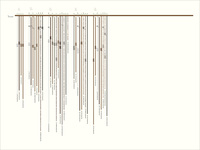| Statistics: |
Original Author: Marcia & Robert Ascher
Museum: Chicago, IL, Chicago, IL, USA
Museum Number: 111407
Provenance: Unknown
Region: Unknown
|
# of Cords: 39 (30p 9s)
# of Unique Cord Colors: 9
Benford Match: 0.7755
# Ascher Sums (pps, ips, cps, sps,...): 9 (8, 0, 0, 0,...)
Similar Khipu: Previous (AS159) Next (AS212)>
|
|
| Notes: |
Ascher Databook Notes:
- Pendant 18 is broken at 2 cm. We are assuming that a 9.5 cm fragment stored with the khipu, broken at both ends, is its continuation.
- The khipu, received by the museum in 1925, was part of the collection of Charles F Gunther. Its provenance was stated as Peru. The khipu was received by the museum in a basket made of woven reeds (13.0 cm x 6.0 cm x 34.0 cm). The basket also contained 41 spindles, 55 sticks and needles, 4 whorls, 1 bundle of sticks, 2 skeins of yarn, 7 miscellaneous samples of rope, reed, and textiles, and 1 bag of unspun cotton fiber. The color of the cotton fiber was similar to the browns of the khipu cords. There is no statement as to whether or not the khipu was found in the basket and none of the yarn or fiber colors are sufficiently distinctive to associate them with the khipu.
- By spacing the khipu is separated into 5 groups. By color and values the groups form 3 parts: part I is a group of 4 pendants; part II is two groups of 6 and 8 pendants respectively; and part III is two groups of 6 pendants each.
- Part II
Because of color and subsidiary placement, we align the 6 pendants in the first group with the 8 in the second group as follows:
That is, Part II consists of P21k k=(1,...,6) and P22k k=(1,2,3',3,..., 7).
Then the color and subsidiary consistencies are:
For j=(1,2):
- P2j1 is W with an MB subsidiary
- P2j2 and its subsidiary are B, RG, or B:RG
- P2j5 is KB:W
- P2j6 is KG
- Subsidiaries are present for k=(1,2) and not for k=(3,...,6).
- Part III
- For both groups the color pattern is B or RG with a B subsidiary, W with a KB subsidiary, B, KB:W or K:W alternating with B:W, KG.
- For both groups subsidiaries are present in positions 1 and 2 but not in the other positions.
- Some values appear in the same positions in both groups: the third position in each has value 1; the sixth position has value 0; and the subsidiary of the second position has value 0.
- Parts II and III
- By color and value the first pendant position in each group of Part II is related to the second position in each group of Part III and vice versa. That is:
For j=(1,2)
- P2j1 and P3j2 are W with a KB subsidiary
- P2j2 and P3j1 and their subsidiaries are B or RG or B:RG
- 22 & 2 ≤ P2j1, P3j2 ≤ 26
- 6 ≤ P2j2, P3j1 ≤ 11
- The fifth and sixth positions in both groups in both parts are related by color. Namely:
For i=(2,3); j=(1,2)
- Pij5 is KB:W or KB:W interspersed with B:W
- Pij6 is KG
- The subsidiary placement is consistent for both groups of both parts.
There are subsidiaries for Pijk for k=(1,2) and not k=(3,...,6) for i=(1,2); j=(1,2)
- Parts I, II and III
- The 38 values on the khipus are in three ranges: 0 to 11; 22 to 26; and 35 to 50. Those in the highest range are all multiples of 5.
- Eleven is a pendant value, sum of consecutive pendant values, sum of a group of pendant values, sum of a pendant and its subsidiary, and sum of similarly placed subsidiaries. The summands can be related as follows:
| 2 & 2 | 4 & 1 | 2 | |
P223 | P223' | sub of P223' |
|
| 4 | 4 | 2,1 | | P111 |
P112 | P113 | P114 |
| 4 & 4 | 3 | | P311 |
sub of P311 |
| 8 | 3 | | sub of P321 |
sub of P311 |
| 11 | | P212 |
|







